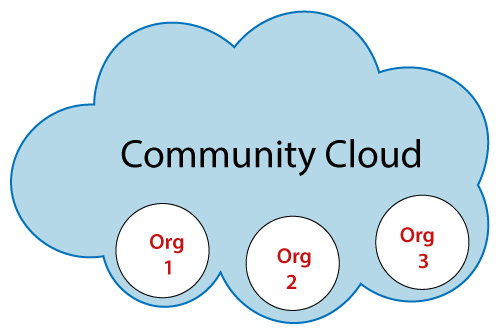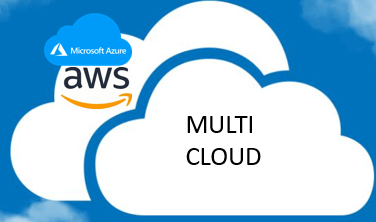Types of Cloud Computing
Cloud computing is like renting space on the internet for storing and processing data. Instead of keeping everything on your computer or phone, you use powerful computers located somewhere else, called data centers. These data centers are managed by companies like Amazon, Google, and Microsoft.
Types of Clouds
There are five main types of cloud computing based on how they are set up and used:
- Public Cloud
- Private Cloud
- Hybrid Cloud
- Community Cloud
- Multi-Cloud

1. Public Cloud
Definition: Public cloud services are offered over the internet and are available to anyone who wants to use them. These services are provided by third-party providers.

Characteristics:
- Accessibility: Accessible to anyone with an internet connection.
- Shared Infrastructure: Resources are shared among multiple users.
- Scalability: Easily scalable based on demand.
- Pay-per-Usage: Users pay only for the resources they use.
- Managed by Service Providers: Maintenance and security are handled by the service provider.
- Reliability and Redundancy: Providers ensure high reliability with redundant systems.
Advantages:
- Lower costs compared to private and hybrid clouds.
- No need for maintenance as it is managed by the provider.
- Highly scalable and flexible.
- Accessible from anywhere with an internet connection.
- Rapid deployment of services.
Disadvantages:
- Less secure as resources are shared.
- Performance depends on internet speed.
- Data is controlled by the service provider.
- Potential compliance and regulatory issues.
- Risk of vendor lock-in.
Examples:
- Amazon Web Services (AWS)
- Microsoft Azure
- Google Cloud Platform (GCP)
2. Private Cloud
Definition: Private cloud is used exclusively by one organization. It can be managed internally or by a third party.

Characteristics:
- Exclusive Use: Dedicated to a single organization.
- Control and Security: Higher control over data and security.
- Customization: Can be tailored to specific needs.
- Scalability: Can scale within the organization's resources.
- Performance and Reliability: Better performance control.
- Compliance: Easier to meet regulatory requirements.
Advantages:
- High security and privacy.
- Better performance and space capacity.
- Full control over the cloud environment.
- Suitable for organizations with strict compliance needs.
Disadvantages:
- Higher costs for setup and maintenance.
- Requires skilled personnel to manage.
- Limited scalability compared to public cloud.
- Slower deployment timelines.
- Risk of outdated technology.
Examples:
- VMware vSphere
- Microsoft Azure Stack
- OpenStack
3. Hybrid Cloud
Definition: A hybrid cloud combines public and private clouds, allowing data and applications to be shared between them.

Characteristics:
- Integration of Public and Private Clouds: Combines the benefits of both.
- Flexibility and Scalability: Dynamic resource allocation.
- Enhanced Security: Control over sensitive data.
- Cost Optimization: Balances cost and efficiency.
- Data Portability: Move data between clouds as needed.
Advantages:
- Greater security than public cloud.
- Flexible resource allocation.
- Reduced risk with a mix of private and public clouds.
- Better business continuity and disaster recovery.
Disadvantages:
- Complex management.
- Dependence on service providers.
- Potential data integration challenges.
- Higher costs for managing multiple environments.
Examples:
- Google Application Suite
- Office 365
- AWS
4. Community Cloud
Definition: Community cloud is shared among several organizations with common concerns (e.g., security, compliance).

Characteristics:
- Shared Infrastructure: Accessible to a specific community.
- Community-Specific Services: Tailored to meet the community's needs.
- Community Ownership and Management: Managed by one or more organizations within the community.
- Enhanced Security: Higher security than public cloud.
- Cost Sharing: Costs are shared among the community members.
Advantages:
- Cost-effective for the community.
- Better security than public cloud.
- Encourages collaboration and knowledge sharing.
- Customizable to meet community needs.
Disadvantages:
- Not suitable for every organization.
- Security not as high as private cloud.
- Limited scalability and performance.
- Potential conflicts among community members.
Examples:
- Health Care community cloud
5. Multi-Cloud
Definition: Multi-cloud uses multiple cloud services from different providers to meet various needs.

Characteristics:
- Multiple Cloud Providers: Utilizes services from various providers.
- Diversification and Risk Reduction: Reduces risk of vendor lock-in.
- Flexibility and Vendor Independence: Choose the best services from different providers.
- Service and Cost Optimization: Optimize costs by selecting suitable providers.
- Enhanced Reliability: Improved performance and availability.
Advantages:
- Avoids dependency on a single vendor.
- Enhances reliability and resilience.
- Optimizes costs and services.
- Meets compliance requirements.
- Access to specialized services.
Disadvantages:
- Increased management complexity.
- Potential higher costs.
- Challenges in data governance.
- Integration and compatibility issues.
Examples:
- AWS
- Microsoft Azure
- Google Cloud Platform
Comparison Table
| Parameter | Public Cloud | Private Cloud | Hybrid Cloud | Community Cloud | Multi-Cloud |
|---|---|---|---|---|---|
| Host | Service provider | Enterprise/Third party | Enterprise/Third party | Community/Third party | Multiple providers |
| Users | General public | Selected users | Selected users | Community members | Multiple organizations |
| Access | Internet | Internet, VPN | Internet, VPN | Internet, VPN | Internet, VPN |
| Owner | Service provider | Enterprise | Enterprise | Community | Multiple organizations |
| Cost | Pay-per-usage | Infrastructure investment | Mixed (variable) | Shared cost | Variable depending on usage |
| Security | Provider's responsibility | Enhanced control | Varied (depends on setup) | Varied (depends on setup) | Varied (depends on setup) |
| Scalability | Highly scalable | Scalable within resources | Scalable within resources | Scalable within resources | Scalable within resources |
| Customization | Limited control | High control | Varied (depends on setup) | Varied (depends on setup) | Varied (depends on setup) |
| Resource Sharing | Shared among users | Not shared | Varied (depends on setup) | Shared among community | Shared among providers |